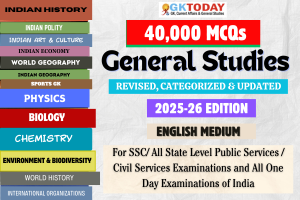Multiple Choice Quiz Questions (MCQs) on Ancient Indian History for General Studies and GK preparation of SSC, NDA, CDS, UPSC, UPPSC and State PSC Examinations.
1. The rulers of which dynasty were first to make land grants to Brahmins?
[A] Maurya
[B] Sunga
[C] Satvahana
[D] Kanvas
Show Answer
Correct Answer: C [ Satvahana ]
Notes:
The rulers of Sarvanana dynasty were the first to make land grant to Brahmins.
2. The reign of which of the following reigns was known as golden age for Mathura school of art?
[A] Indo-Greeks
[B] Sakas
[C] Kushanas
[D] Gupta
Show Answer
Correct Answer: C [ Kushanas ]
Notes:
The period of Kushana King Kanishka, Huviska and Vasudeva is considered to be golden age for Mathura school of art. The theme of Mathura school of art may vary from Buddhist to Brahmanical to sometimes secular. The more stress is given to the inner beauty and facial emotions rather than bodily gesture. The sculptures were made on White-spotted red stones.
3. The inscriptions of Ashoka and the Brahmi script were deciphered by ___?
[A] Alexander Cunningham
[B] James Princep
[C] Max Muller
[D] Mortimer Wheeler
Show Answer
Correct Answer: B [ James Princep ]
Notes:
James Princep (1799-1840) was an English scholar, orientalist and antiquary. He was the founding editor of the Journal of the Asiatic Society of Bengal and is best remembered for deciphering the Kharosthi and Brahmi scripts of ancient India. He was the first to decipher the inscriptions of Ashoka and the Brahmi script.
4. Who was the founder of Chalukya Dynasty ?
[A] Vishnuvardhan
[B] Pulakesin I
[C] Kirtivarman I
[D] Pulakesin II
Show Answer
Correct Answer: B [ Pulakesin I ]
Notes:
The founder of Chalukya dynasty, Pulakesin I established a small kingdom with Badami (or Vatapi) as its capital in Bijapur District, Karnataka .
5. World’s first oil paintings have been found in which of the following countries?
[A] India
[B] Pakistan
[C] Afghanistan
[D] Iran
Show Answer
Correct Answer: C [ Afghanistan ]
Notes:
In 2008, oil paintings were discovered in caves near the village of Bamiyan in central Afghanistan. The paintings have been radiocarbon dated to more than the 5th century CE, making them the oldest known oil paintings in the world.
6. The Sakas introduced Satrap system of government along with whom?
[A] Parthians
[B] Kushans
[C] Sungas
[D] Satavahanas
Show Answer
Correct Answer: A [ Parthians ]
Notes:
The Sakas introduced Satrap system of government along with Parthians that was similar to that of the Achaemenid and Seleucid systems in Iran. Under this system, the kingdom was divided into provinces each under military governor Mahakshatrapa (great satrap). The governors of lower status were called kshatrapas (satraps). These governors had the power to issue their own inscriptions and mint their own coins.
7. Sudarshan lake repaired second time under the reign of _?
[A] Skandgupta
[B] Kumargupta
[C] Rudradaman
[D] Parnadatta
Show Answer
Correct Answer: A [ Skandgupta ]
Notes:
The Junagarh inscription gives the information about the Sudarshan lake that the lake was an artificial reservoir, was built by the Mauryan emperors for checking floods. Around 150 AD, the lake was repaired by the Shaka ruler Rudradaman-I. And, it was again repaired under the Skandgupta’s reign (415 AD- 455 AD) by his governor Parnadatta.
8. Which site has given the earliest evidence of pottery in the Indian subcontinent?
[A] Brahmagiri
[B] Chirand
[C] Mehrgarh
[D] Burzahom
Show Answer
Correct Answer: C [Mehrgarh]
Notes:
Mehrgarh, located in the Kacchi Plain of Balochistan, Pakistan, is one of the earliest sites with evidence of farming and herding in South Asia. Dated back to around 7000 – 5500 BCE, it is also known for its significant contribution in unearthing one of the earliest instances of pottery making.
9. The Nitisara of Kamandaka, also known as the Kamandakiya-Nitisara, was composed during the period of:
[A] Satavahana dynasty
[B] Gupta dynasty
[C] Kalachuri dynasty
[D] Nanda dynasty
Show Answer
Correct Answer: B [Gupta dynasty]
Notes:
The Nitisara of Kamandaka, also known as the Kamandakiya-Nitisara, was composed during the period of Gupta Dynasty. It was based on Kautilya’s Arthashastra
10. Which among the following was capital of Mitrakas?
[A] Kosambi
[B] Vallabhi
[C] Odantapuri
[D] Vikramsila
Show Answer
Correct Answer: B [Vallabhi]
Notes:
After the decline of the Gupta Empire, Maitraka dynasty was founded by Senapati (general) Bhatarka, who was a military governor of Saurashtra under Gupta Empire, established himself as the independent empire around 475 CE. The Maitraka dynasty ruled western India (now Gujarat) from approximately 475 to approximately 776 CE from their capital at Vallabhi.
 These questions are part of GKToday's 40,000+ GK Questions Course in GKToday Android Application which provides more than 40K questions with explanations suitable for all Competitive Exams of India.
These questions are part of GKToday's 40,000+ GK Questions Course in GKToday Android Application which provides more than 40K questions with explanations suitable for all Competitive Exams of India.
